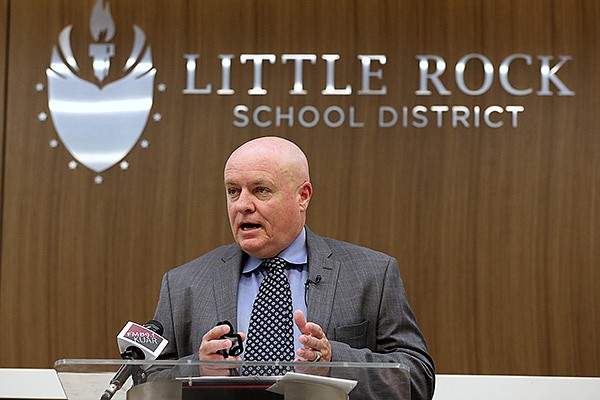Shortly after Michael Poore arrived in the capital city after being named the superintendent of the Little Rock School District, he and district Athletic Director John Daniels formed an athletic think-tank.
The district was a rotating door of superintendents since 1982, with 23 coming and going before Poore arrived in 2016. The instability and de-emphasis of athletics over the years produced a decline in participation in sports, most notably football.
The think-tank included Fitz Hill, Keith Jackson, Muskie Harris, Bill Ingram, Marcus Elliott, Jay Gadberry and others in hopes of improving district athletics.
Poore was Bentonville’s superintendent from 2011-16. He along with Daniels implemented several ideas from the think-tank while also increasing funding and getting the community involved.
Arkansas Children’s Hospital has been a key partner. The district previously had one athletic trainer, but now it has five for four high schools thanks to the partnership with the hospital.
The district also has attracted more coaching talent and seen an increase in participation numbers for football and other sports. The stronger athletic programs and participation numbers are a win-win for athletes and the city of Little Rock, Hill said.
“The number one thing I hope that people understand is the better the athletic programs are in Little Rock, the safer our city is because that means we have maximum people participating unlike what we saw in previous years when those things weren’t taking place,” said Hill, who’s a member of the Arkansas Board of Education. “We understand the criminal issue we’re dealing with in Little Rock, and oftentimes it’s because kids are not engaged and participating.”
Hill and the Little Rock School District Athletic Foundation spearheaded the 6th & Goal campaign to restart sixth-grade football in the district. Money for the program was raised by the foundation.
“I think our city has been paying for that in other ways because we were trying to save, but actually it was more expensive because if you look at violence, it ties into it,” Hill said.
The district was a major source of talent for the University of Arkansas football program until the early 2000s, when the number of prospects dried up. Little Rock Parkview tight end Erin Outley and quarterback Landon Rogers in December became the first prospects from the district to ink with the Hogs since 2005.
Ingram, a 1985 graduate of Parkview, played football when the Patriots had about 100 athletes out for the sport. Prior to the hiring of Brad Bolding as Parkview’s coach, the Patriots saw numbers as low as 25 to 30 on the varsity level. This past season, there were 68 on the varsity squad and about 100 when counting junior varsity.
Little Rock Southwest Coach Daryl Patton had 93 athletes out for football in August, and Little Rock Central had about 60.
Ingram praised Poore and Daniels for listening and acting on suggestions.
“It feels good being a part of it and seeing a lot of things coming back,” Ingram said. “It’s moving in the right direction. I’m confident in that.”
When Poore left Northwest Arkansas for Little Rock, retired Bentonville coach Barry Lunney Sr. and former Arkansas tight ends coach Barry Lunney Jr. told him the district was vital to the success of the Razorbacks football program.
“If Little Rock can get stronger, it’s certainly going to benefit our university,” Lunney Sr. said.
Lunney, whose father John played football for the Razorbacks from 1946-49 under John Barnhill, is a big believer in Poore.
“Michael Poore loves kids. He will fight for those kids,” Lunney Sr. said. “He’s a guy that’s truly in it for the right reasons. He realizes the significance that athletics play in your total educational environment.”
The investments in people and facilities have paid off for the district with more athletes attending college on scholarships while also making the district more appealing to students.
“The other thing about a strong athletic program is it creates enrollment in your district,” Poore said. “If we don’t compete and have quality athletic programs, we’re going to lose kids to surrounding areas. We have obviously for a long period of time, and I think that tide is turning.”

